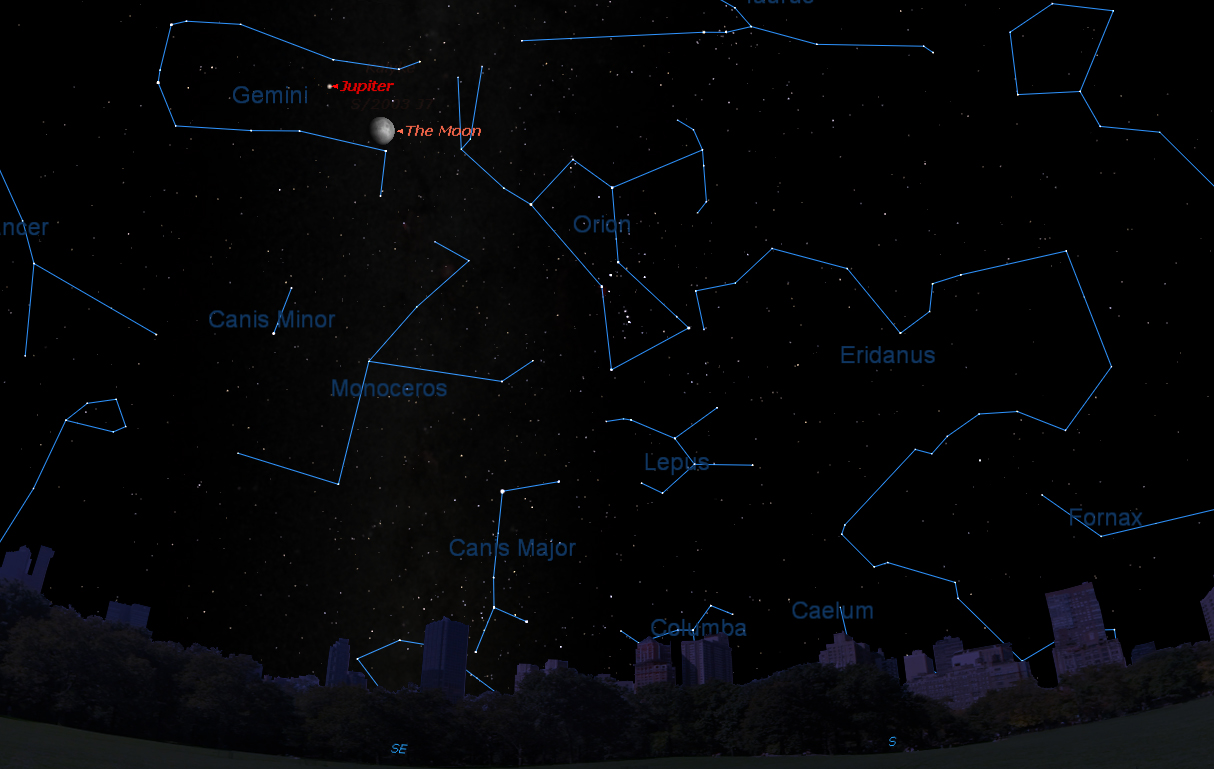Jupiter Shines Near the Moon Tonight: How to See It

If your sky is clear tonight (Feb. 10), be sure to check out the southeast sky about an hour or so after sundown for an eye-catching site: Jupiter and the moon shining together.
Weather permitting, stargazers can find the celestial meet-up on about halfway up in the southeastern evening sky. You'll immediately see the moon, which will be at its waxing gibbous phase, en route to becoming a full moon on Valentine's Day (Friday, Feb. 14).
This evening, observers may notice a very bright, silvery "star" shining with a steady glow to the right or lower right of the moon. That's not a star, however, but in reality, the biggest planet in our solar system: Jupiter. Both moon and planet will keep each other company as they move across the night sky through the course of the night. [Jupiter Reigns in February's Night Sky (Video)]
Casual observers looking skyward will almost certainly wonder what that bright object near the moon happens to be, and I would encourage all of my fellow broadcast meteorologists to let their listeners and viewers in on what they're seeing in the night sky.
Jupiteris ideally placed for evening viewing, shining high and free where trees and other obstructions reach in vain to hide it, and where even the ill-effects of atmospheric seeing are at their least. Jupiter currently shines between the legs of Gemini. It reaches its highest point in the sky — transiting the meridian, as the astronomers would say — around 9:30 p.m. your local time. It sets during the predawn hours, soon after 4 a.m. your local time.
For amateur astronomers, Jupiter is the best of the planets and a superb telescopic object. Its disk shows more illuminated surface area than all the other planets combined. Users of the very smallest telescopes or even steadily held binoculars can identify Jupiter’s some or all four of its bright moons at any given time.
But the planet's disk itself also draws a lot of attention. In large telescopes, observers with telescopes can view its cloud belts, sometimes one or more can look strongly disturbed, full of knots and sprouting festoons or on the other side of the coin, perhaps looking like pale belts crossing the planet. And recent reports suggest that the famous Great Red Spot now appears darker than it has been for several years. As always, seeing much detail on Jupiter requires a good quality telescope, good atmospheric seeing, and patience behind the eyepiece.
Breaking space news, the latest updates on rocket launches, skywatching events and more!
Lastly, if clouds hide your view of the moon with Jupiter, don't fret. They'll be together again on March 9.
Editor's note: If you snap an amazing photo of Jupiter near the moon tonight, or have any other night sky view you'd like to share with Space.com for a possible story or image gallery, please contact managing editor Tariq Malik at spacephotos@space.com.
Joe Rao serves as an instructor and guest lecturer at New York's Hayden Planetarium. He writes about astronomy for Natural History magazine, the Farmer's Almanac and other publications, and he is also an on-camera meteorologist for News 12 Westchester, N.Y. Follow Space.com on Twitter @Spacedotcom. We're also on Facebook & Google+. Original story on Space.com.

Joe Rao is Space.com's skywatching columnist, as well as a veteran meteorologist and eclipse chaser who also serves as an instructor and guest lecturer at New York's Hayden Planetarium. He writes about astronomy for Natural History magazine, Sky & Telescope and other publications. Joe is an 8-time Emmy-nominated meteorologist who served the Putnam Valley region of New York for over 21 years. You can find him on Twitter and YouTube tracking lunar and solar eclipses, meteor showers and more. To find out Joe's latest project, visit him on Twitter.
